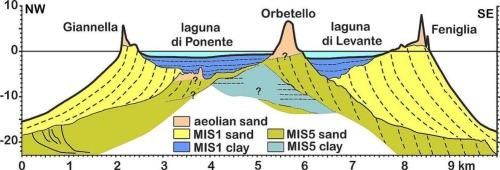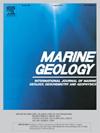Double tombolo formation by regressive barrier widening and landside submergence: The case of Orbetello, Italy
IF 2.6
3区 地球科学
Q2 GEOSCIENCES, MULTIDISCIPLINARY
引用次数: 0
Abstract
The double tombolo of Orbetello, in Italy, has formed during the Holocene around an ancient central tombolo. Earlier models consider that its sand barriers formed as sand spits that stretched from the mainland to a coastal island before enlarging seawards. This evolution, however, remains speculative. In order to test these models, we conducted the first study of a double tombolo that combines coring of its sand barriers and comprehensive imaging of its internal structure using sub-bottom acoustic surveys offshore and in the back-barrier. Sediment ages were constrained by 14C, luminescence, and U/Th dating. Acoustic images below the lagoon show that the barriers are in fact broad regressive strandplains that initiated on the flanks of the preexisting central isthmus when sea level was −7 ± 1 m lower than today. The strandplains then rose upwards and outwards, tracking sea level rise over the past 7 kyr. The oldest and lowest parts of the strandplains were flooded into the shallow intervening lagoon. The central isthmus is composed of regressive sand barriers accreted around a MIS 5.5 core during subsequent stages MIS 5.3 and MIS 5.1. The emplacement of the isthmus interrupted longshore drift between the mainland and the coastal island, converting the flanks of the initial tombolo into terminal sinks in which sand accretion accelerated, spurring early and rapid regression during the Holocene. A review of the environmental parameters conducive to double tombolo formation suggests that double tombolos may represent a frequent, albeit short-lived stage during the enlargement of single tombolos.

退行性屏障加宽和陆坡淹没形成的双墓道:意大利奥贝泰罗的案例
意大利奥尔贝泰罗的双墓穴是在全新世期间围绕着一个古老的中央墓穴形成的。早先的模型认为,它的沙障是作为沙嘴形成的,从大陆延伸到沿海岛屿,然后向海扩展。然而,这种演变仍然是推测性的。为了验证这些模型,我们首次对双墓穴进行了研究,研究结合了对其沙障的取芯以及利用近海和后沙障的海底声学勘测对其内部结构的全面成像。通过 14C、发光和 U/Th 测定法确定了沉积物的年龄。泻湖下方的声学图像显示,屏障实际上是宽阔的退行性滩地,在海平面比现在低 -7 ± 1 米时,它位于先前存在的中央地峡的侧翼。然后,地峡平原向上和向外隆起,与过去 7 千年的海平面上升同步。地峡最古老和最低的部分被淹没在中间的浅泻湖中。中央地峡由在随后的 MIS 5.3 和 MIS 5.1 阶段围绕 MIS 5.5 核心增生的回归沙障组成。地峡的形成阻断了大陆与沿海岛屿之间的长岸漂移,使最初的墓穴侧翼变成了末端汇,沙土在此加速沉积,刺激了全新世早期的快速回归。对有利于双墓道形成的环境参数的审查表明,双墓道可能是单墓道扩大过程中的一个频繁出现的阶段,尽管是短暂的。
本文章由计算机程序翻译,如有差异,请以英文原文为准。
求助全文
约1分钟内获得全文
求助全文
来源期刊

Marine Geology
地学-地球科学综合
CiteScore
6.10
自引率
6.90%
发文量
175
审稿时长
21.9 weeks
期刊介绍:
Marine Geology is the premier international journal on marine geological processes in the broadest sense. We seek papers that are comprehensive, interdisciplinary and synthetic that will be lasting contributions to the field. Although most papers are based on regional studies, they must demonstrate new findings of international significance. We accept papers on subjects as diverse as seafloor hydrothermal systems, beach dynamics, early diagenesis, microbiological studies in sediments, palaeoclimate studies and geophysical studies of the seabed. We encourage papers that address emerging new fields, for example the influence of anthropogenic processes on coastal/marine geology and coastal/marine geoarchaeology. We insist that the papers are concerned with the marine realm and that they deal with geology: with rocks, sediments, and physical and chemical processes affecting them. Papers should address scientific hypotheses: highly descriptive data compilations or papers that deal only with marine management and risk assessment should be submitted to other journals. Papers on laboratory or modelling studies must demonstrate direct relevance to marine processes or deposits. The primary criteria for acceptance of papers is that the science is of high quality, novel, significant, and of broad international interest.
 求助内容:
求助内容: 应助结果提醒方式:
应助结果提醒方式:


